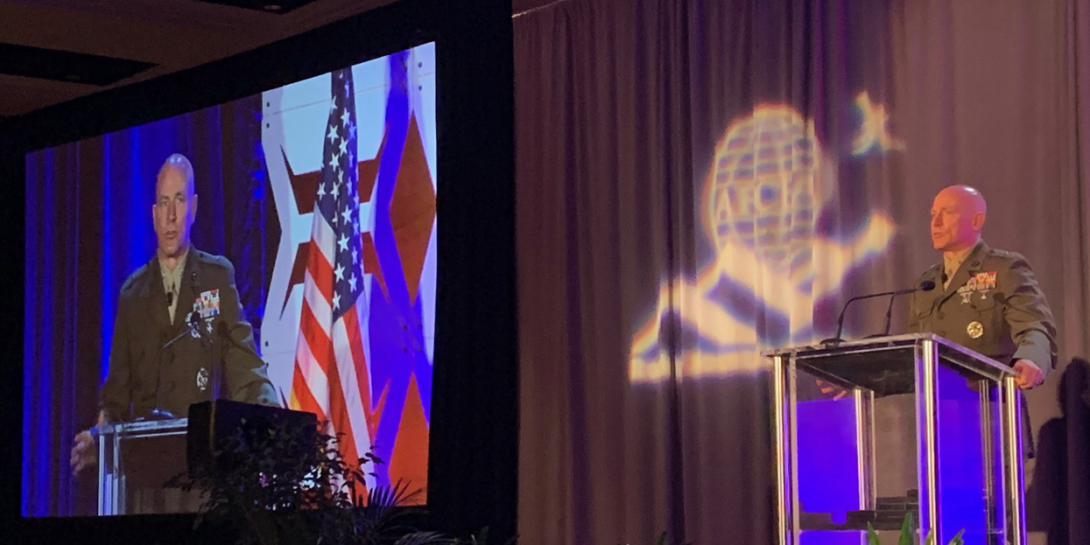Bringing Cyber into Space
Last August 30, the U.S. Space Command become the 11th unified combatant command of the U.S. Department of Defense. In that role, the command will be conducting defensive, and when necessary, offensive cyber capabilities to protect key space-based assets and guard its part of the military’s network, called the DODIN.
No longer an uncontested domain, space is a region that revisionist world powers are increasingly disrupting. The risks from our adversaries operating in space are real and are a threat to our nation, stated Brig. Gen. Joseph Matos, USMC, J-6, U.S. Space Command.
“They show the intent, capability and will to do so,” he noted. “We see them gathering intelligence on us and, in some cases, infiltrating our networks in order to exfiltrate that to use against us. The threat goes beyond our systems, but also to our critical infrastructure, such as electricity and water and other areas in which we rely upon to conduct defense operations in space. We need to be prepared to actively operate and defend and, in some cases, use offensive cyber to conduct our space operations.”
The Space Command’s geographical area of designation is 100 kilometers above the Earth, and in that domain the new command is responsible for deterring conflict, as well as defending the ability of the United States and its allies to freely operate, explained Gen. Matos.
The new combatant command is responsible for delivering space-related combat capabilities to the Joint forces, including: satellite communications; position, navigation and timing; Global Positioning System (GPS); and intelligence, surveillance and reconnaissance, the general stated.
As the warfighting arm of the military in the space domain, the command’s means to address adversarial risks and protect U.S. capabilities are essentially digitally-based. “Space and cyber ops are uniquely intertwined,” he said. “I think it is clear that DODIN [Department of Defense Information Network] operations, defensive and offensive, will all be required as part of a large multidomain fight in space.”
Speaking at the Rocky Mountain Cyberspace Symposium on February 6—his first AFCEA engagement since taking the helm as the command's cyber leader at Peterson Air Force Base, Colorado—Gen. Matos stipulated that the command also would develop joint space warfighters trained to conduct DODIN-related measures, as well as prepare defensive and offensive cyber operators to conduct the necessary missions in order to project power into cyberspace.
Building these cyber-related capabilities and personnel is a key focus of the command at present, Gen. Matos offered. Space Command is in the process of outlining the roles, responsibilities, functions for cyber operations, the necessary command and control (C2) and lines of authorities, he clarified.
Leaders are conducting operational planning, which will be approved by the command staff. The next steps, the general said, are to identify concept of operations that will guide the cyber operations of Space Command and outline personnel, policies, processes and procedures.
Central to planning is the standup of the command’s Joint Cyber Center. Every combatant command has such a center to support its continuing cyber operations. It will coordinate and direct cyber operations for the command and connect up to the U.S. Cyber Command, Joint Force Headquarters (JFHQ)-DODIN and other combatant commands, and it integrates cyber effects, the general clarified. Leaders are flushing out the location for the center and its personnel structure.
They are taking a template from Strategic Command with 36 people in their center and considering if that is the right level. Officials also are seeing where the internal coordination sits within the command, whether it is with the J-3 or J-6. “Our goal is to have our first members of our Joint Cyber Center in place by this early summer,” Gen. Matos offered.
The 16th Air Force will be the cyber service element that supports the command, providing personnel and expertise across the command’s three lines of effort: DODIN operations, defensive and offensive cyber operation. “This will be a tremendous benefit to us because at this time we don’t have the resource to do it ourselves,” Gen. Matos said..
BG Joseph Matos @USMC J6, @US_SpaceCom is helping to define how the new combatant command will conduct cyber operations. “The goal is to have cyber ops built right from the beginning. We are baking in cyber ops from the outset." #RMCS20 @AFCEARMC @AFCEA pic.twitter.com/yDt2aBvcTK
— Kimberly Underwood (@Kunderwood_SGNL) February 6, 2020
As a nascent entity, the Space Command is not quite ready to conduct cyber-based operations, and in the near-term will rely on other organizations, such as Strategic Command to provide support and cover until the new command builds up its processes and capabilities and conducts cyber missions themselves. “We realize that this support will not last forever, nor does General Raymond want it to,” he said, speaking of the Space Commander’s intent.
In addition, the command has a strong relationship with and are learning from the U.S. Cyber Command as they integrate operations.
“We need to be able to assess the impact of our DODIN ops, DCO [defensive cyber ops] and offensive ops against our ability to command and control and conduct space operations across the globe,” Gen. Matos noted. “Where necessary, we must proactively defend, and when necessary, mitigate the negative impact our adversaries are trying to impose on our networks and our systems and at the same time using offensive cyberspace effects to deny, degrade or exploit our adversaries' capability to use space against us.”





Comments